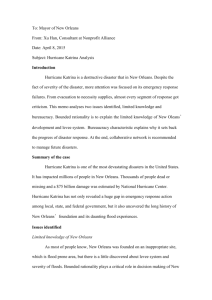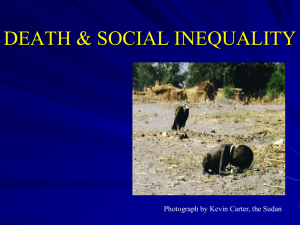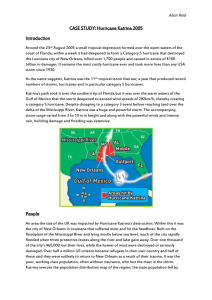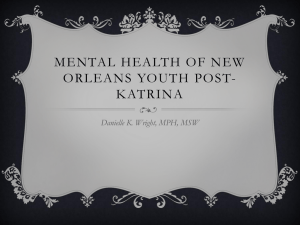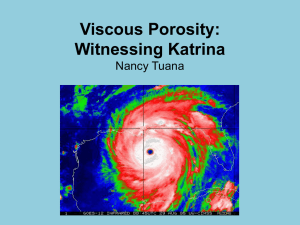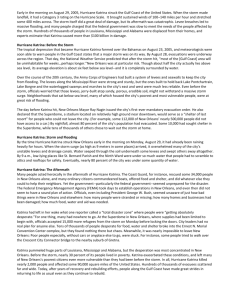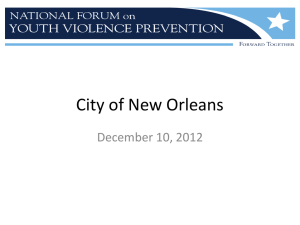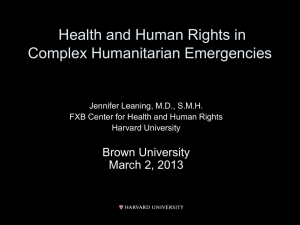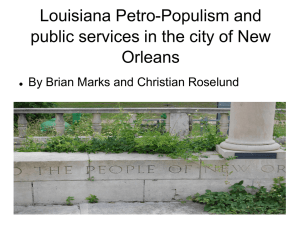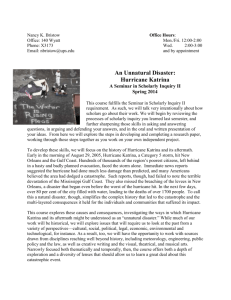Landscape of Remembrance: Spatial Distribution of New Orleans
advertisement
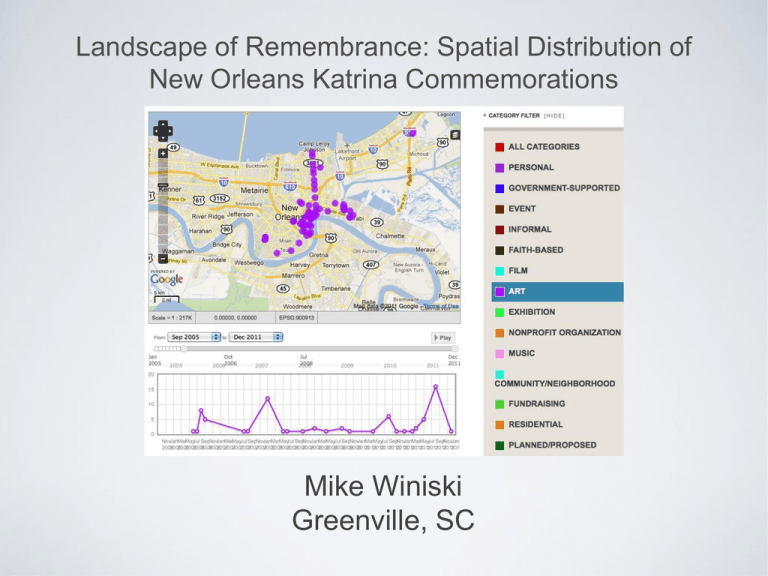
Landscape of Remembrance: Spatial Distribution of New Orleans Katrina Commemorations Mike Winiski Greenville, SC http://www.flickr.com/photos/navillusphotography/3626506521/sizes/z/in/photostream/ http://www.flickr.com/photos/midnightquill/416540958/sizes/z/in/photostream/ http://www.flickr.com/photos/13023662@N07/2095391083/sizes/l/in/photostream/ http://www.artscouncilofneworleans.org/article.php?story=20081208164221496 http://www.pbs.org/arts/gallery/ruin-and-revival/storm-cycle-slideshow/ http://www.flickr.com/photos/michelledwright/5594207635/ http://photos.nola.com/photogallery/2010/08/hurricane_katrina_body_art_9.html http://photos.nola.com/photogallery/2010/08/hurricane_katrina_body_art_15.html http://photos.nola.com/photogallery/2010/08/hurricane_katrina_body_art_43.html Purpose • Remember • • • • • • • • Grieve Honor lost loved ones Hold accountable / Ascribe responsibility Express anger Confirm community through shared experience Tell stories Express hope Promote understanding within and beyond community “Only by remembering, and holding city, state, and federal government officials responsible for their actions, can a true Gulf South rebuild commence in the appropriate fashion” (Brinkley, 2007, p.xxv). “From this day forward, the Memorial will be a constant reminder not only of what we have endured, but also of our ability to come together, in the wake of tragedy, with limitless compassion” (Daniels, 2011). Axioms of Resilience “In the aftermath of disaster, the very legitimacy of government is at stake. Citizens have the opportunity to observe how their leaders respond to an acute crisis and, if they are not satisfied, such events can be significant catalysts for political change” (Vale & Campanella, 2005, p. 340). 4. “Local Resilience is Linked to National Renewal” 5. “Resilience is Underwritten by Outsiders” 7. “Remembrance Drives Resilience” 9. “Resilience Exploits the Power of Place” 10. “Resilience Casts Opportunism as Opportunity” (Vale & Campanella, 2005) Exclusion “Cultural, just as individual memory is an extremely narrow space regulated by rigid principles of selection and forgetting. Those who examined the borderline— Gray speaking for the poor peasants, Woolf speaking for women, Ellison speaking for African Americans— were for the first time calling attention to the structural mechanisms that exclude whole groups of the population from active participation in the cultural memory” (Assmann, 2009, p. 48). Research Questions 1. How do the locations and forms of Katrina commemorations (both formal and informal) in greater New Orleans correspond to storm impact? 2. Are certain contingents, as represented by place and demographics, excluded from the commemoration process? 3. Do the form and nature of these commemorations vary across the city and different neighborhoods? If so, how? (Campanella, 2006, p. 313) (Campanella, 2006, p. 303) (Campanella, 2006, p. 311) (Campanella, 2006, p. 376) Methodology 1. Defining / Quantifying ‘Impact’ 2. Defining Commemoration and Category 3. Data Collection 4. Analysis Flood Depth Death Rate (The Times Picayune, 2009) Return Rate (Park & Tse, 2010) Return Rate (Park & Tse, 2010) Defining Commemoration 1. Has a discernible location (temporary or permanent) 2. Visibly invokes a remembrance of Katrina event 3. Invokes memory of event or collective loss, rather than individual memorials (grave markers, etc.) “In truth architecture defines our daily lives ... how we get up in the morning, how we move through our cities, in what conditions we will complete our work, and where our kids will play. We remain creatures susceptible to our environment. Whether this existence be harmonious or cumbersome, it is architecture which hones our memories” (Feireiss and Pitt, 2009, p. 470). Brad Pitt http://www.makeitrightnola.org/index.php/work_progress/mir_homes/1809_deslonde_street/ Data Collection Categorizing Commemoration Graffiti Analysis 1) To what degree, if any, is the distribution of commemorations and types spatially autocorrelated across the entire study area? Univariate Moran’s I; 2) Which local units have the most significant impact on the overall degree of spatial autocorrelation? -LISA (Local Indicators of Spatial Association) / simulation via Monte Carlo methods; 3) Do the local units with the most significant impact on spatial autocorrelation correspond to areas of high ‘impact’, poverty, or high minority percentage? *Exploratory Data Analysis (EDA) possibly performed with Geoda Significance map of Auckland City created by Mike Winiski in Geography 586 (Lesson 8) using Geoda and data from https://www.eeducation.psu.edu/geog586/book/export/html/1817 Challenges and Questions • Do we have enough data to allow for analysis at the neighborhood level, or will analysis require a higher level of aggregation--like planning districts? • Sampling bias • Resolving discrepancies in death rates / Data access • New Orleans East • Outsider • Statistically analyzing changes over time “A good map tells a multitude of little white lies; it suppresses truth to help the user see what needs to be seen. Reality is threedimensional, rich in detail, and far too factual to allow a complete yet uncluttered twodimensional graphic scale model. Indeed a map that did not generalize would be useless” (Monmonnier, 1996, p.25). Acknowledgement • Thanks to my advisor Lorraine s Dowler for her expertise, encouragement, tough questions, and guidance; • Ronald Lewis, R. Omar Casimire, and the residents of New Orleans; •Drew Woten and Diane Boyd, Furman University; •Susannah, Emma, and Jordan Winiski. References Assmann, A. (2009). The politics of cultural memory. In L. B. Lambert & A. Ochsner (Eds.), Moment to monument: The making and unmaking of cultural significance (pp. 35-49). Piscataway, NJ: Transaction Publishers. Baum, D. (2010). Nine Lives: Mystery, Magic, Death, and Life in New Orleans (Reprint.). Spiegel & Grau. Bliss, J. & Newton-Small, J. (2006, August 24). Insurance battles slow post-Katrina rebuilding, reshaping coast. Retrieved from http://www.bloomberg.com/apps/news?pid=newsarchive&sid=aCXOMJp7Hr2o&refer=news Boyd, E. (2006). Preliminary Summary Report of Hurricane Katrina Deceased Victim Recovery Locations in Louisiana. ESRI GIS Public Health conference proceedings. (pp. 23-26). Denver, CO. Boyd, E. C. (2010). Estimating and Mapping the Direct Flood Fatality Rate for Flooding in Greater New Orleans Due To Hurricane Katrina. Risk, Hazards & Crisis in Public Policy, 1(3), 91. doi:10.2202/1944-4079.1017 Brinkley, D. (2007). The Great Deluge: Hurricane Katrina, New Orleans, and the Mississippi Gulf Coast. Harper Perennial. Bullard, R. (n.d.). KATRINA AND THE SECOND DISASTER: A Twenty-Point Plan to Destroy Black New Orleans. Retrieved September 13, 2011, from http://www.ejrc.cau.edu/Bullard20PointPlan.html Campanella, R. (2006). Geographies of New Orleans: Urban Fabrics Before the Storm. Center For Louisiana Studies. Daniels, J. (2011). Commemorating 9/11/11. Retrieved from http://www.911memorial.org/commemorating-91111 Farrar, Margaret. (2009). Home/Sick: Memory, Place, and Loss in New Orleans. Theory & Event, 12(4), 1. Gabe, T., & Service, L. of C. C. R. (2005). Hurricane Katrina: Social-demographic characteristics of impacted areas. Gesch, D. (2007). Topography-based Analysis of Hurricane Katrina Inundation of New Orleans. Science and the Storms: The USGS Response to the Hurricanes of 2005, 53. Hawkins, H. (2011). Dialogues and Doings: Sketching the Relationships Between Geography and Art. Geography Compass, 5(7), 464-478. doi:10.1111/j.1749-8198.2011.00429.x Jonkman, S. N., Maaskant, B., Boyd, E., & Levitan, M. L. (2009). Loss of life caused by the flooding of New Orleans after Hurricane Katrina: analysis of the relationship between flood characteristics and mortality. Risk analysis, 29(5), 676–698. References Lambert, L., & Ochsner, A. (2009). Moment to Monument: The Making and Unmaking of Cultural Significance. Transcript Verlag. Logan, J. R. (2006). The impact of Katrina: Race and class in storm-damaged neighborhoods. S4, Spatial Structures in the Social Sciences, Hurricane Katrina Project. Providence, RI: Brown University. http://www. s4. brown. edu/Katrina/report. pdf. Monmonier, M., & Blij, H. J. de. (1996). How to Lie with Maps (2nd ed.). University Of Chicago Press. Park, H. and Tse, A. (2010, August 27). Mapping the recover of New Orleans. Retrieved from http://www.nytimes.com/interactive/2010/08/27/us/20100827-katrina-resettlement.html Pitt, W. a C. by B., & Feireiss, K. (2009). Architecture in Times of Need: Make It Right - Rebuilding New Orleans’ Lower Ninth Ward (illustrated edition.). Prestel USA. Sharkey, P. (2007). Survival and Death in New Orleans: An Empirical Look at the Human Impact of Katrina. Journal of Black Studies, 37, 482-501. doi:10.1177/0021934706296188 Smith, J., & Rowland, J. (2005). Temporal analysis of floodwater volumes in New Orleans after Hurricane Katrina. Science and the storms: The USGS response to the hurricanes of. The Times Picayune (2009). Deadly flooding from Hurricane Katrina’s levee breaches. Retrieved from http://blog.nola.com/news_impact/2009/08/katrina-deaths.gif Tough, P. (2008, August 14). A Teachable Moment - Education in a Post-Katrina New Orleans. New York Times. Retrieved from http://www.nytimes.com/2008/08/17/magazine/17NewOrleans-t.html Tuan, Y.-F. and S. H. (2001). Space and Place: The Perspective of Experience. Univ Of Minnesota Press. U.S. Department of Housing and Urban Development’s Office of Policy Development and Research. (2006). Current housing unit damage estimates: Hurricanes Katrina, Rita, and Wilma. Retrieved from http://www.huduser.org/publications/destech/GulfCoast_HsngDmgEst.html Vale, L., & Campanella, T. (2005). Axioms of Resilience. In L. Vale & T. Campanella (Eds.), The Resilient City (pp. 335–356). New York: Oxford University Press. Wilson, C. (2011, January 16). New Orleans School Sows Seeds in Lower 9th Ward. New York Times, p. A23.
